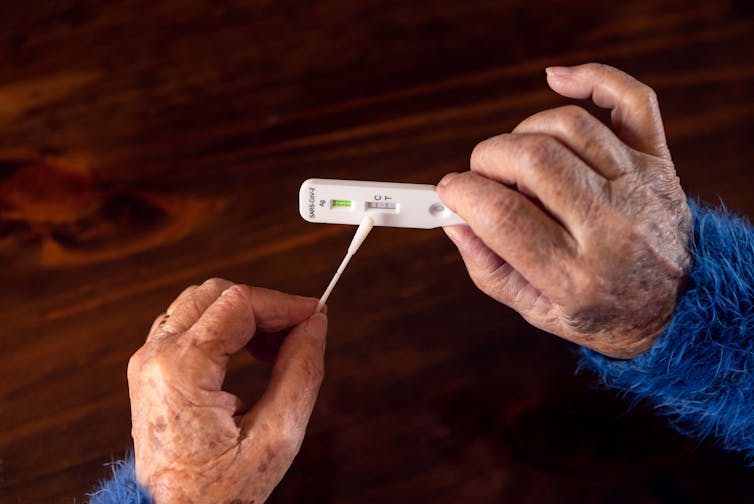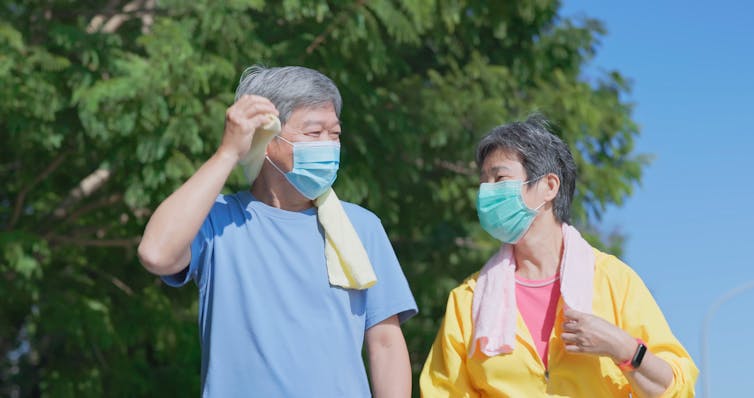Source: The Conversation (Au and NZ) – By Benjamin Cowie, Director, WHO Collaborating Centre for Viral Hepatitis, The Peter Doherty Institute for Infection and Immunity

Australia is experiencing the fourth wave of COVID for 2022, with the number of people hospitalised with COVID trending to levels seen in winter and ongoing high levels of deaths. New COVID waves are expected to occur every three to four months for some time.
Earlier in the pandemic, COVID treatments mostly focused on those hospitalised with serious infection. Now, oral antiviral medicines nirmatrelvir/ritonavir (Paxlovid) and molnupiravir (Lagevrio) are largely prescribed by GPs for people who test positive for COVID and are at greater risk of severe illness.
In our roles in Victoria’s Department of Health, we analysed the impact of antivirals on the risk of death and hospitalisation among Victorians aged 70 and over during the winter 2022 COVID wave.
Our analysis, which is yet to be published or independently verified by other scientists, found both Paxlovid and Lagevrio reduced the risk of hospitalisation and death. And the results were better for Paxlovid.
Several previous studies have shown Paxlovid is highly effective at preventing severe illness and death from COVID. It’s currently Australia’s first-line COVID antiviral treatment for early treatment in the community.
However, a recent trial has raised questions about the effectivness of the other antiviral available in Australia, Lagevrio. While there’s evidence it’s effective at treating COVID, it’s no longer recommended in the United Kingdom because it’s not considered cost-effective.
While Australia’s clinical guidelines are yet to change, our analysis suggests both Paxlovid and Lagevrio have a role to play in Australia’s treatment arsenal. Some people who are unable to have Paxlovid will benefit from Lagevrio.

Shutterstock
How well do these antivirals work?
Initial clinical trials of Paxlovid and Lagevrio in unvaccinated adults show they significantly reduce the risk of hospitalisation or death from COVID.
Those who took Lagevrio were 30% less likely to be hospitalised or die with COVID.
In a separate trial, those that took Paxlovid were 89% less likely to be hospitalised or die.
Read more:
I have mild COVID – should I take the antiviral Paxlovid?
Recently, a pre-print analysis (which is still undergoing external scientific review) reported on a large clinical trial in the United Kingdom. It found Lagevrio didn’t reduce hospitalisation or the risk of death for vaccinated adults (0.8%) compared to standard care.
It found treatment did reduce recovery time by four days. It also reduced contact with GP services, the time tests remained positive, and the amount of virus detected.
However it’s important to note the population studied in the UK trial were relatively young: 86% were aged 50–70. They were therefore at lower risk of severe COVID than the over-70s age group who represent most of those prescribed Lagevrio in Australia.
So the study may not have adequately demonstrated the potential benefit for older adults who are at higher risk of severe illness from COVID.
On the other hand, real-world (or observational) studies from Hong Kong, Israel and Poland have reported Lagevrio reduces the chance of high-risk patients dying from COVID.

Shutterstock
Our analysis
We used our routine data and linkage techniques to examine the risk of hospitalisation in more than 27,000 Victorians aged over 70 years diagnosed with COVID and the risk of death in more than 32,000 people who did and didn’t undergo treatment.
This analysis involved collaboration between the Victorian and Australian government health departments, and linked Pharmaceutical Benefits Scheme (PBS) prescriptions, COVID vaccination, diagnoses, hospitalisation, and death data.
After controlling for various factors influencing the risk of hospitalisation and death (vaccination history, sex, socioeconomic status, hospitalisation history, and aged care residency), we found significant benefits for both drugs.
We found:
-
COVID medicines substantially reduced risk of hospitalisation (32% for Paxlovid, 26% for Lagevrio) and risk of death (72% for Paxlovid, 54% for Lagevrio)
-
early treatment with a COVID antiviral provided the greatest benefit – treatment with either drug within one day of diagnosis reduced the risk of hospitalisation by 37%, and death by 63%
-
the benefits for reducing the risk of hospitalisation were not seen if people were treated two or more days after diagnosis
-
the benefits for reducing the risk of death were not seen if treated four or more days after diagnosis.
Read more:
COVID drugs in Australia: what’s available and how to get them
Some important limitations of this analysis are that it’s observational, so we can’t control for a number of factors associated with hospitalisation and death from COVID.
Another limitation is the choice of antiviral medicine by the prescribing GP may be influenced by factors which are also associated with the risk of severe outcomes. This could bias the estimates of the treatment’s effect.
A strength of this analysis is the large size, and the fact it reports on the entire population of Victorians aged 70 years and above diagnosed with COVID during the winter wave.
So what does it mean?
In our analysis, the effect of Paxlovid was greater than that of Lagevrio. This is in keeping with the current available evidence and its recommendation as a first-line therapy.
However, Paxlovid is not safe for people with some underlying conditions, such as severe kidney or liver disease. It also has a number of drug interactions with commonly used medications.
So when Paxlovid is unsuitable or not available, Lagevrio is a suitable option.
Because Lagevrio has fewer interactions and can be used in a wider range of patients, it has been pre-placed in residential aged care, for rapid access.
Australians with lower socioeconomic status are more likely to be hospitalised with or die from COVID. So developing strategies to increase antiviral access for people who face the greatest burden of COVID will help reduce these inequities.
Antivirals are an important additional tool as part of an multi-layered response to COVID. This aims to reduce community transmission and the risk of illness in priority populations, and to protect our health system in the months to come and waves ahead of us.
Read more:
Two years into the pandemic, unequal access to COVID-19 treatments threatens the global recovery
Acknowledgements: The analysis mentioned above includes contributions from Daniel West, Indra Parta, Jose Canevari, Nick Haslett, Dennis Wollersheim, Marcellin Martinie and Rebecca Dawson from the Victorian Department of Health’s Modelling and Analytical Epidemiology team.
![]()
Benjamin Cowie is Acting Chief Health Officer at the Victorian Department of Health.
Brett Sutton is Victoria’s Chief Health Officer.
Christina Van Heer is a Senior Analyst at the Victorian Department of Health.
Suman Majumdar is a Deputy Chief Health Officer at the Victorian Department of Health.
– ref. Paxlovid is Australia’s first-line COVID antiviral but Lagevrio also prevents severe disease in over-70s – https://theconversation.com/paxlovid-is-australias-first-line-covid-antiviral-but-lagevrio-also-prevents-severe-disease-in-over-70s-195349







